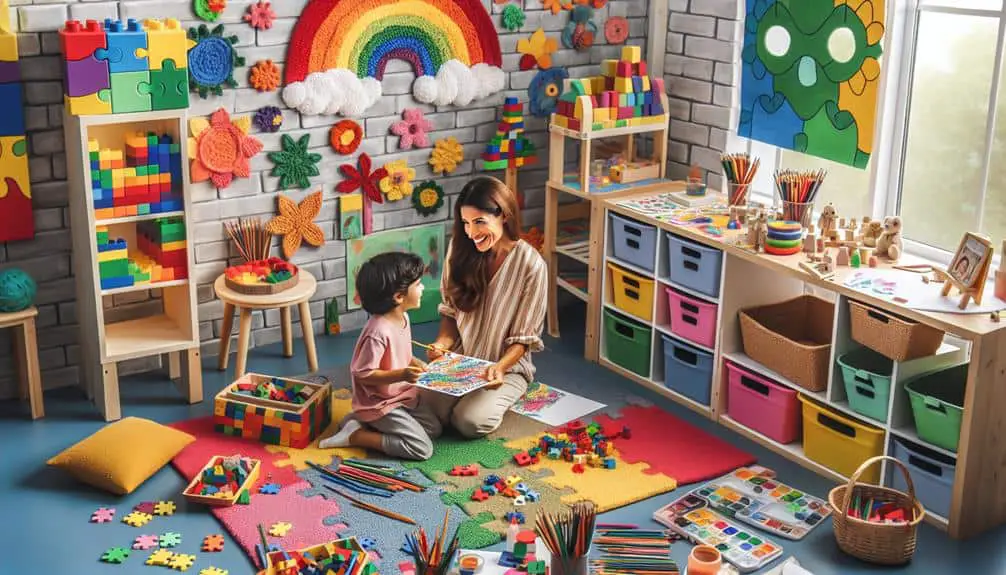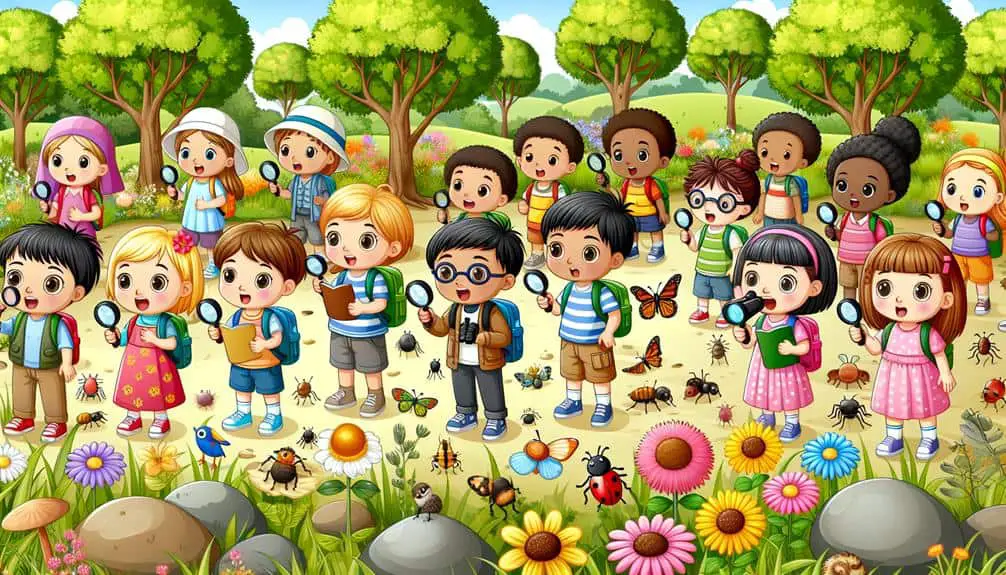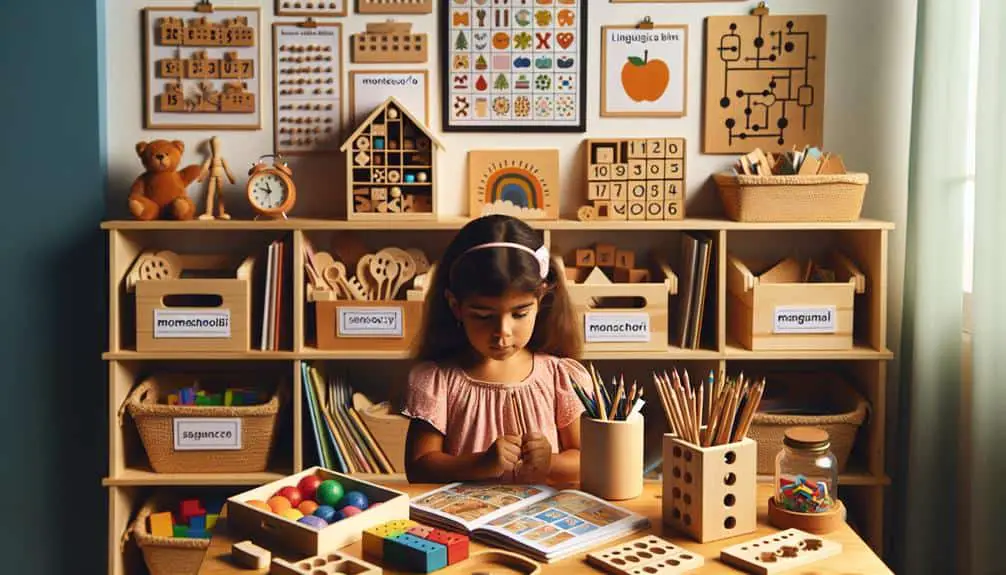Get ready to immerse your preschooler in a world of fun and learning right at home! Set up play stations with building blocks and sensory bins. Organize toys for easy access and label for organization skills. Rotate stations to keep things fresh and exciting. Include learning objectives like counting and creative activities. Empower social skills through role-playing and cooperative games. Engage in sensory play for hands-on learning experiences. Foster empathy and teamwork through engaging activities. There's a whole new world of engaging play waiting for you to explore further!
Key Points
- Consider developmental needs and interests for engaging play setups.
- Rotate play stations regularly for sustained interest and creativity.
- Incorporate learning objectives for educational fun and skill development.
- Promote social interaction through cooperative games and role-playing activities.
- Utilize sensory play to ignite curiosity and develop fine motor skills.
Benefits of Structured Play
Engaging in structured play with your preschooler can greatly enhance their cognitive development and social skills. Through activities that stimulate problem-solving skills and creativity enhancement, your child can experience a boost in their overall cognitive abilities.
Structured play provides a safe environment for children to explore various scenarios, encouraging them to think critically and come up with solutions. This process not only sharpens their problem-solving skills but also fosters emotional regulation as they learn to navigate different challenges.
Setting up Play Stations
Ready to create some awesome play stations for your preschoolers?
Let's chat about station selection tips,
how to organize play materials,
and the importance of rotating stations regularly for maximum fun and learning!
Let's get those little ones smiling and engaged in structured play.
Station Selection Tips
When arranging play stations for preschoolers, keep in mind their interests and developmental needs to create engaging and educational experiences. Consider the station layout to guarantee there's enough space for children to move around comfortably and interact with different activities. Place stations in a way that allows for easy supervision while still offering a sense of independence for the little ones.
Select play materials that are age-appropriate and align with the learning goals you have in mind. Incorporate a variety of toys and tools that encourage creativity, problem-solving, and sensory exploration.
For example, you could have a station with building blocks for developing fine motor skills, a reading nook with colorful books for language development, or a sensory bin filled with different textures for tactile stimulation.
Organize Play Materials
To create dynamic and interactive play stations for preschoolers, thoughtful organization of play materials is essential. When setting up play stations at home, consider using storage solutions like bins, shelves, and baskets to keep toys and supplies tidy and easily accessible. Playroom organization is key to creating a welcoming and engaging environment for your little ones.
Labeling materials can also be a helpful strategy to keep everything in its place. Use clear labels or pictures on containers to help your preschoolers know where to find and return items after playtime. This simple practice can promote independence and organization skills in children at an early age.
Additionally, consider implementing toy rotation to keep play stations fresh and exciting. By periodically swapping out toys and materials, you can reignite your preschooler's interest and creativity. This practice also helps prevent play spaces from becoming cluttered and overwhelming.
With a well-organized play area and thoughtful toy rotation, you can create a stimulating and enjoyable play environment for your preschooler to explore and learn.
Rotate Stations Regularly
For a fun and engaging playtime experience, consider switching up the play stations regularly to keep your preschooler's interest piqued and creativity flowing. Station organization is key to making this a success. By rotating stations, you provide your little one with new and exciting experiences each time they play.
Set up different station themes like a pretend kitchen, a coloring corner, or a building block area. This variety keeps things interesting and encourages exploration. Don't forget to add some play area decoration to enhance the atmosphere. Simple touches like colorful posters or themed rugs can make a big difference in setting the scene for imaginative play.
Changing stations also allows your child to develop a range of skills. From fine motor skills in the arts and crafts station to social skills in the pretend play area, each station offers unique learning opportunities. So, get creative with your station setups and watch your preschooler's playtime come to life!
Incorporating Learning Objectives
Incorporate key learning objectives into structured play activities to enhance your preschooler's educational experience. Learning through play is a fantastic way to engage your child while ensuring they're meeting important developmental milestones.
By incorporating creativity into activities such as building blocks or pretend play, you can foster critical thinking and problem-solving skills.
Encourage interactive learning by asking open-ended questions or providing opportunities for your child to explore new concepts through hands-on experiences.
Educational fun should be at the core of your play sessions, whether it's counting colorful toys, identifying shapes, or learning about the natural world through sensory activities.
Remember that children absorb information best when they're enjoying themselves, so make sure to keep the atmosphere light and enjoyable.
Creating a Play Schedule
Now, let's map out a playful and engaging schedule to make the most of structured playtime with your preschooler. When creating a play schedule, consider incorporating playtime flexibility to adapt to your child's needs and moods. This approach allows for a balance between structured activities and free play, fostering creativity and independence.
Playroom organization is key to maintaining a conducive environment for interactive activities and creative exploration. Arrange toys and materials in accessible bins or shelves, making it easy for your child to choose what they want to play with. Rotating toys periodically can also keep the playroom fresh and exciting.
Plan a mix of activities that promote learning and fun. Include interactive activities like building blocks, puzzles, or pretend play to encourage social skills and imagination. Incorporate creative exploration through art projects, sensory bins, or storytelling to stimulate your child's cognitive development.
Engaging in Sensory Play
Explore the world of sensory play with your preschooler to ignite their curiosity and creativity through hands-on experiences. Sensory exploration is a fantastic way for your little one to learn about the world around them while having messy fun.
Set up a sensory bin with items like rice, beans, or water beads for them to touch, feel, and scoop. This tactile experience helps develop fine motor skills and encourages imaginative play.
Another engaging activity is creating sensory bottles filled with colorful liquids and glitter. These mesmerizing bottles can captivate your child's attention and provide a calming effect. Encourage them to shake the bottles and watch as the contents swirl and mix together.
Don't forget about sensory art projects! Finger painting, playing with playdough, or molding with clay are all excellent ways for your preschooler to express themselves creatively while engaging in sensory play.
Promoting Social Interaction
Hey there, ready to amp up your preschooler's social skills through structured play?
Role-playing games can help them understand empathy by stepping into different perspectives, while cooperative activities like group puzzles or building projects foster bonding and teamwork.
These interactive play sessions aren't just fun; they're powerful tools for nurturing your little one's social development!
Role-Playing for Empathy
Engage your preschoolers in role-playing activities to help them develop empathy and enhance their social interaction skills. Through imaginative play, children can step into different roles, experiencing various emotions and perspectives.
Encouraging your little ones to pretend to be someone else in different scenarios allows them to understand and connect with different feelings, fostering empathy towards others.
Role-playing can be a powerful tool for teaching empathy as it requires children to contemplate the thoughts and emotions of the characters they're portraying. Whether pretending to be a doctor caring for a patient or a teacher helping a student, these scenarios help children practice understanding and responding to the feelings of others.
Cooperative Games for Bonding
Step into the world of cooperative games with your preschoolers to foster bonding and promote social interaction among them. Team building becomes fun and engaging when little ones work together towards a common goal.
Encourage communication skills by playing games like 'Pass the Parcel,' where kids pass an object around a circle while music plays, promoting turn-taking and interaction.
Trust exercises are essential for developing strong bonds among preschoolers. Try activities like 'Trust Falls,' where children take turns falling back into their friends' arms, teaching them to rely on and support each other.
Problem-solving games, such as building a block tower together or solving puzzles as a team, can enhance critical thinking skills while strengthening relationships.
Cooperative games not only provide entertainment but also create a platform for preschoolers to learn valuable social skills. By incorporating these activities into playtime, you're setting the stage for meaningful interactions and lasting friendships among your little ones.
Frequently Asked Questions
How Can I Adapt Structured Play for Different Age Groups?
When adapting structured play for various ages, consider age-appropriate adaptations and playtime modifications. Tailor activities to match developmental stages. By customizing games and tasks, you can make playtime engaging and beneficial for all age groups.
What Are Some Tips for Managing Multiple Play Stations at Once?
To manage multiple play stations at once, try setting up a play rotation schedule. Involve parents to help with time management. Establish clear play boundaries. This way, everyone gets a chance to enjoy the different activities!
How Do I Address Behavioral Challenges During Structured Play?
When tackling behavioral challenges during structured play, remember that positive reinforcement can work wonders. Redirection is your secret weapon! Set consistent boundaries and communicate clearly. You've got this! It's like taming a wild unicorn!
Can Structured Play Be Integrated Into Outdoor Activities?
You can totally amp up fun by integrating structured play into outdoor activities! Think outdoor games like nature hunts or obstacle courses. These not only engage but also offer sensory activities that preschoolers adore.
What Are Some Creative Ways to Incorporate Technology Into Play Sessions?
Alright, let's jump right in! For interactive games, try apps that blend fun with learning. Explore puzzles, storytelling, and hands-on activities. Technology can enhance playtime by sparking curiosity and boosting creativity in your preschooler.



